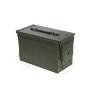GunnyUSMC
Member
Last month my buddy Matt came down from South Dakota to visit and repair some of his gun stocks that he had shipped down here. Matt makes it down here about once every three years and has stock work for me. I think that I have done about $3000 worth of free stock work for Matt in the pass 10 years, maybe more. But what are friends for.
But from time to time Matt will send me something to pay me back for the work I’ve done. Today the mail man dropped of two boxes from Matt.
Here’s what was in them. Two WWII ammo cans and a 410 ammo crate from India. Matt knows how much I like ammo cans and creates.








But from time to time Matt will send me something to pay me back for the work I’ve done. Today the mail man dropped of two boxes from Matt.
Here’s what was in them. Two WWII ammo cans and a 410 ammo crate from India. Matt knows how much I like ammo cans and creates.
























